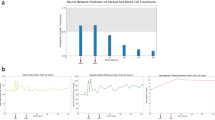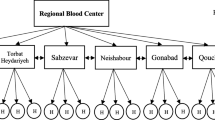Abstract
Typing and crossmatching blood is a significant cost for most hospitals, regardless of whether the blood is actually transfused. Many hospitals have implemented a Maximum Surgical Blood Order Schedule, MSBOS, to control over-ordering of blood units for surgery. The research presented in this article examines the use of neural networks for predicting the quantity of blood required by individual patients undergoing abdominal surgery (e.g. splenectomy). A comparison is made between the neural network predictions at a particular hospital versus the current MSBOS methodology for ordering surgical blood, by using the crossmatch to transfusion ratio. Results from the neural network transfusion predictions for the abdominal aortic aneurysm (AAA) surgery imply that neural networks can significantly improve the transfusion efficiency of hospitals. However, further examination of neural network capabilities for predicting the transfusion needs of patients undergoing other types of abdominal surgeries indicates that for operations other than the AAA, neural networks tend to under-predict the transfusion requirements of ten percent of the patients. Even if not used to limit over-ordering of blood for surgical transfusions, neural networks may be used as an intelligent decision support system to evaluate the current efficiency of hospital transfusion practices and to indicate beneficial changes to current MSBOS values.
Similar content being viewed by others
References
Barnard, E. and Wessels, L.: Extrapolation and interpolation in neural network classifiers, IEEE Control Systems 12 (1992), 50–53.
Baxt, W. G. and Skora, J.: Prospective validation of artificial neural network trained to identify acute myocardial infarction, The Lancet 347 (January 6, 1996), 12–15.
Bounds, D. G., Lloyd, P. J. and Mathew, B. G.: A comparison of neural network and other pattern recognition approaches to the diagnosis of low back disorders, Neural Networks 3 (1990), 583–591.
Clark, J. A. and Ayoub, M. M.: Blood and component wastage report: A quality assurance function of the hospital transfusion committee, Transfusion 29 (2), (1989), 139–142.
Dorffner, G. and Porenta, G.: On using feedforward neural networks for clinical diagnostic tasks, Artificial Intelligence in Medicine 6 (1994), 417–435.
Dorman, B. H., Spinale, F.G., Bailey, M. K., Kratz, J. M. and Roy, R. C.: Identification of patients at risk for excessive blood loss during coronary artery bypass surgery: Thromboelastograph versus coagulation screen, Anesthesia Analgesia 76 (4), (1993), 694–700.
Dybowski, R. and Gant, V.: Artificial neural networks in pathology and medical laboratories, The Lancet 346 (November 4, 1995), 1203–1207.
Fisher, R. E., Scott, J. A. and Palmer, E. L.: Neural networks in ventilation-perfusion imaging, Radiology 198 (March 1996), 699–706.
Goodnough, L. W., Soegiarso, R. W., Birkmeyer, J. D. and Welch, H. G.: Economic impact of inappropriate blood transfusions in coronary artery bypass graft surgery, The American Journal of Medicine 94 (1993), 509–514.
Hasley, P. B., Lave, J. R., Hanusa, B. H., Arena, V. C., Ramsey, G., Kapoor, W. N. and Fine, M. J.: Variation in the use of red blood cell transfusions, Medical Care 33 (11) (1995), 1145–1160.
Hassoun, M. H., Wang, C. and Spitzer, A. R.: NNERVE: Neural Network Extractions of Repetitive Vectors for Electromyography-Part II: Performance analysis, IEEE Transactions on Biomedical Engineering 41 (1994), 1053–1061.
Jain, A. J., Mao, J. and Mohiuddin, K. M.: Artificial neural networks: A tutorial, Computer 29 (1996), 31–44.
Lowery, T. A. and Clark, J. A.: Successful implementation of maximum surgical blood order schedule, Journal of the Medical Association of Georgia 78 (1989), 155–158.
Montague, G. and Morris, J.: Neural-network contributions in biotechnology, Trends in Biotechnology 12 (1994), 312–324.
Murphy, W. G., Phillips, P., Gray, A., Heatley, L., Palmer, J., Hopkins, D. and Crawford, R. J.: Blood use for surgical patients: a study of Scottish hospital transfusion practices, Journal of the Royal College of Surgeons of Edinburgh 40 (1995), 10–13.
Palmer, R. H., Kane, J. G., Churchill, W. H., Goldman, L. and Komaroff, A. L.: Cost and quality in the use of blood bank services for normal deliveries, cesarean sections, and hysterectomies, JAMA 256 (July 11, 1986), 219–223.
Spiess, B. D., Counts, R. B. and Gould, S. A.: Perioperative Transfusion Medicine, Williams and Wilkins, Baltimore, MD, USA, 1998.
Wilkins, M. F., Morris, C. W. and Boddy, L.: A comparison of Radial Basis Function and backpropagation neural networks for identification of marine phytoplankton from multivariate flow cytometry data, Computer Applications in the Biosciences 10 (1994), 285–294.
Author information
Authors and Affiliations
Rights and permissions
About this article
Cite this article
Walczak, S., Scharf, J.E. Transfusion Cost Containment for Abdominal Surgery with Neural Networks. Neural Processing Letters 11, 229–238 (2000). https://doi.org/10.1023/A:1009667711423
Issue Date:
DOI: https://doi.org/10.1023/A:1009667711423




